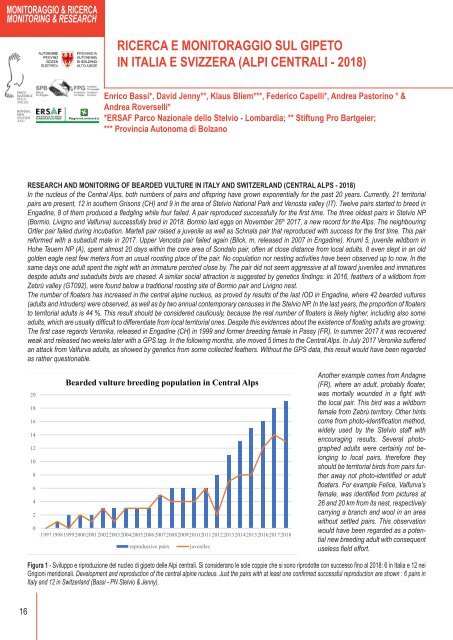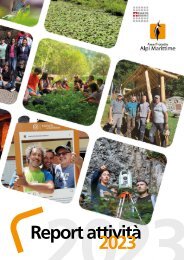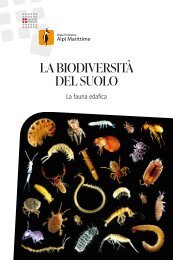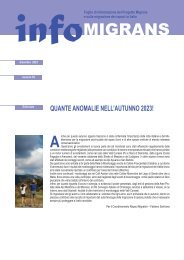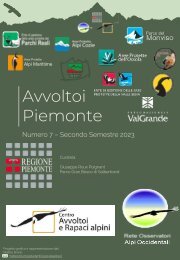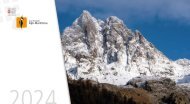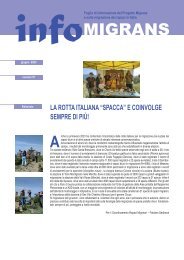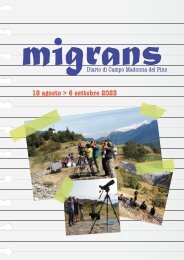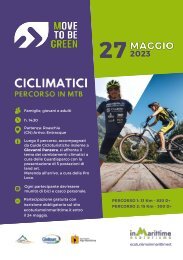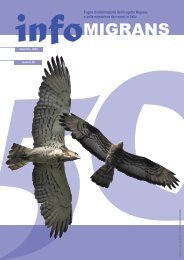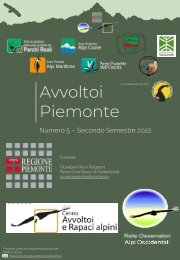infoGIPETO n.35 | dicembre 2018
Periodico d'informazione sul progetto di reintroduzione del gipeto.
Periodico d'informazione sul progetto di reintroduzione del gipeto.
Create successful ePaper yourself
Turn your PDF publications into a flip-book with our unique Google optimized e-Paper software.
MONITORAGGIO & RICERCA<br />
MONITORING & RESEARCH<br />
RICERCA E MONITORAGGIO SUL GIPETO<br />
IN ITALIA E SVIZZERA (ALPI CENTRALI - <strong>2018</strong>)<br />
Enrico Bassi*, David Jenny**, Klaus Bliem***, Federico Capelli*, Andrea Pastorino * &<br />
Andrea Roverselli*<br />
*ERSAF Parco Nazionale dello Stelvio - Lombardia; ** Stiftung Pro Bartgeier;<br />
*** Provincia Autonoma di Bolzano<br />
RESEARCH AND MONITORING OF BEARDED VULTURE IN ITALY AND SWITZERLAND (CENTRAL ALPS - <strong>2018</strong>)<br />
In the nucleus of the Central Alps, both numbers of pairs and offspring have grown exponentially for the past 20 years. Currently, 21 territorial<br />
pairs are present, 12 in southern Grisons (CH) and 9 in the area of Stelvio National Park and Venosta valley (IT). Twelve pairs started to breed in<br />
Engadine, 8 of them produced a fledgling while four failed. A pair reproduced successfully for the first time. The three oldest pairs in Stelvio NP<br />
(Bormio, Livigno and Valfurva) successfully bred in <strong>2018</strong>. Bormio laid eggs on November 26 th 2017, a new record for the Alps. The neighbouring<br />
Ortler pair failed during incubation. Martell pair raised a juvenile as well as Schnals pair that reproduced with success for the first time. This pair<br />
reformed with a subadult male in 2017. Upper Venosta pair failed again (Blick, m, released in 2007 in Engadine). Kruml 5, juvenile wildborn in<br />
Hohe Tauern NP (A), spent almost 20 days within the core area of Sondalo pair, often at close distance from local adults. It even slept in an old<br />
golden eagle nest few meters from an usual roosting place of the pair. No copulation nor nesting activities have been observed up to now. In the<br />
same days one adult spent the night with an immature perched close by. The pair did not seem aggressive at all toward juveniles and immatures<br />
despite adults and subadults birds are chased. A similar social attraction is suggested by genetics findings: in 2016, feathers of a wildborn from<br />
Zebrù valley (GT092), were found below a traditional roosting site of Bormio pair and Livigno nest.<br />
The number of floaters has increased in the central alpine nucleus, as proved by results of the last IOD in Engadine, where 42 bearded vultures<br />
(adults and intruders) were observed, as well as by two annual contemporary censuses in the Stelvio NP. In the last years, the proportion of floaters<br />
to territorial adults is 44 %. This result should be considered cautiously, because the real number of floaters is likely higher, including also some<br />
adults, which are usually difficult to differentiate from local territorial ones. Despite this evidences about the existence of floating adults are growing:<br />
The first case regards Veronika, released in Engadine (CH) in 1999 and former breeding female in Passy (FR). In summer 2017 it was recovered<br />
weak and released two weeks later with a GPS tag. In the following months, she moved 5 times to the Central Alps. In July 2017 Veronika suffered<br />
an attack from Valfurva adults, as showed by genetics from some collected feathers. Without the GPS data, this result would have been regarded<br />
as rather questionable.<br />
20<br />
18<br />
16<br />
14<br />
12<br />
10<br />
8<br />
6<br />
4<br />
2<br />
0<br />
Bearded vulture breeding population in Central Alps<br />
199719981999200020012002200320042005200620072008200920102011201220132014201520162017<strong>2018</strong><br />
reproductive pairs<br />
juveniles<br />
Figura 1 - Sviluppo e riproduzione del nucleo di gipeto delle Alpi centrali. Si considerano le sole coppie che si sono riprodotte con successo fino al <strong>2018</strong>: 6 in Italia e 12 nei<br />
Grigioni meridionali. Development and reproduction of the central alpine nucleus. Just the pairs with at least one confirmed successful reproduction are shown : 6 pairs in<br />
Italy and 12 in Switzerland (Bassi - PN Stelvio & Jenny).<br />
<br />
Another example comes from Andagne<br />
(FR), where an adult, probably floater,<br />
was mortally wounded in a fight with<br />
the local pair. This bird was a wildborn<br />
female from Zebrù territory. Other hints<br />
come from photo-identification method,<br />
widely used by the Stelvio staff with<br />
encouraging results. Several photographed<br />
adults were certainly not belonging<br />
to local pairs, therefore they<br />
should be territorial birds from pairs further<br />
away not photo-identified or adult<br />
floaters. For example Felice, Valfurva’s<br />
female, was identified from pictures at<br />
26 and 20 km from its nest, respectively<br />
carrying a branch and wool in an area<br />
without settled pairs. This observation<br />
would have been regarded as a potential<br />
new breeding adult with consequent<br />
useless field effort.<br />
16


